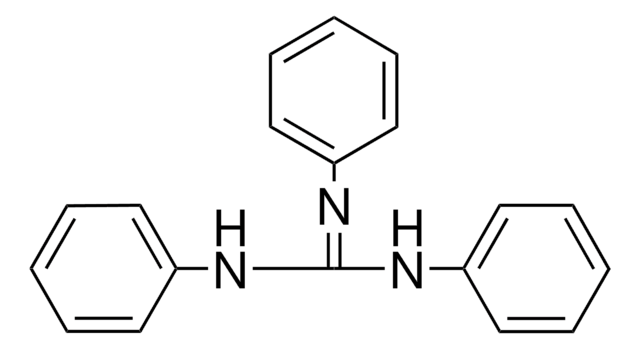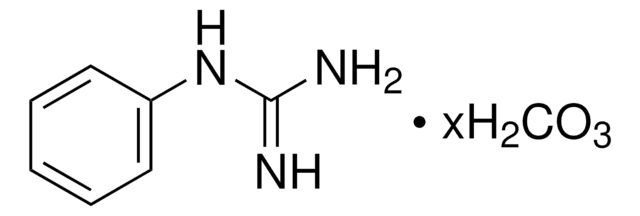1,3-Di-o-tolylguanidine is known to be a selective ligand for the sigma site in the mammalian central nervous system. Behavioral changes, such as hypothermia, reduced pain behavior, circling behavior, and decreased locomotor activity in mice and/or rats were observed after intraperitoneal, subcutaneous, intravenous and/or intranigral injection.
207713
1,3-Di-o-tolylguanidine
99%
Sinônimo(s):
DTG
About This Item
Produtos recomendados
Ensaio
99%
Formulário
solid
pf
176-178 °C (lit.)
solubilidade
water: soluble 70 mg/mL at 20 °C
grupo funcional
amine
cadeia de caracteres SMILES
Cc1ccccc1NC(=N)Nc2ccccc2C
InChI
1S/C15H17N3/c1-11-7-3-5-9-13(11)17-15(16)18-14-10-6-4-8-12(14)2/h3-10H,1-2H3,(H3,16,17,18)
chave InChI
OPNUROKCUBTKLF-UHFFFAOYSA-N
Informações sobre genes
human ... EBP(10682)
Procurando produtos similares? Visita Guia de comparação de produtos
Categorias relacionadas
Palavra indicadora
Warning
Frases de perigo
Classificações de perigo
Acute Tox. 4 Oral
Código de classe de armazenamento
11 - Combustible Solids
Classe de risco de água (WGK)
WGK 3
Ponto de fulgor (°F)
Not applicable
Ponto de fulgor (°C)
Not applicable
Equipamento de proteção individual
dust mask type N95 (US), Eyeshields, Faceshields, Gloves
Escolha uma das versões mais recentes:
Já possui este produto?
Encontre a documentação dos produtos que você adquiriu recentemente na biblioteca de documentos.
-
What is the nature of the biological activity of Product 207713, 1,3-di-o-tolylguanidine?
1 answer-
Helpful?
-
-
What is the solubility of Product 207713, 1,3-di-o-tolylguanidine?
1 answer-
1,3-Di-o-tolylguanidine is soluble in water at 70 micrograms per mL at ambient temperature.
Helpful?
-
-
What is the Department of Transportation shipping information for this product?
1 answer-
Transportation information can be found in Section 14 of the product's (M)SDS.To access the shipping information for this material, use the link on the product detail page for the product.
Helpful?
-
Active Filters
Nossa equipe de cientistas tem experiência em todas as áreas de pesquisa, incluindo Life Sciences, ciência de materiais, síntese química, cromatografia, química analítica e muitas outras.
Entre em contato com a assistência técnica








